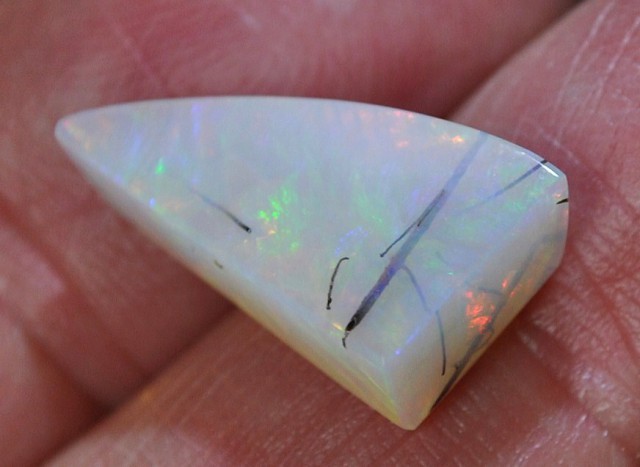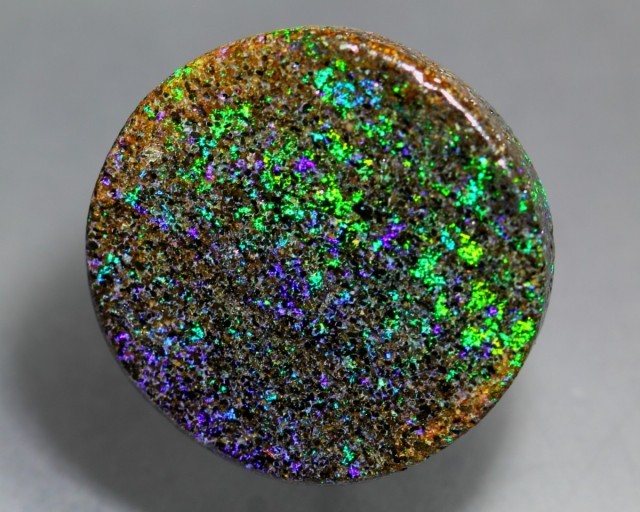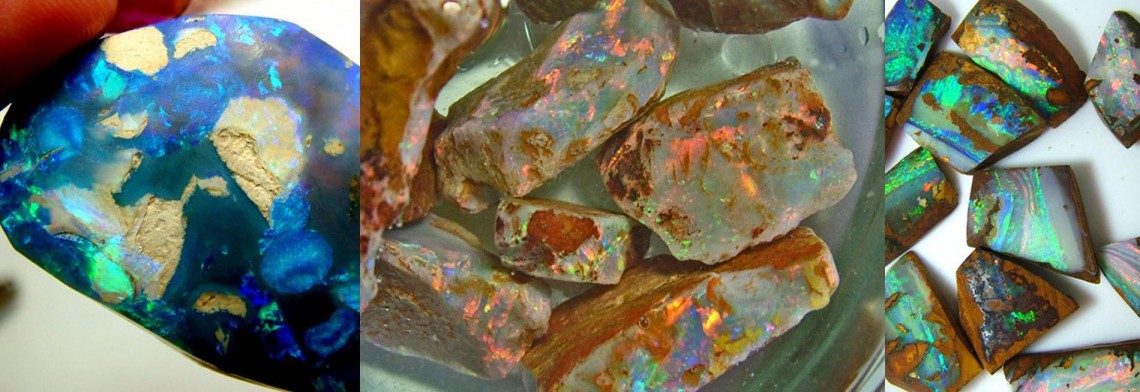
如何在网上购买蛋白石
 您来对地方了,因为网上购买欧泊的第一步就是了解欧泊的相关知识。世界各地的欧泊爱好者都开始选择网上购买,因为您可以直接从产地购买。
您来对地方了,因为网上购买欧泊的第一步就是了解欧泊的相关知识。世界各地的欧泊爱好者都开始选择网上购买,因为您可以直接从产地购买。
最好找一个汇集各类卖家的网站,从澳大利亚的蛋白石矿工到蛋白石批发商,再到国际矿工或批发商,应有尽有。许多买家表示,网上购买蛋白石是最佳选择,因为世界各地的卖家都必须在一个可控的在线环境下展开竞争。
蛋白石矿工必须与其他卖家竞争定价,因此如果矿工定价过高,蛋白石就卖不出去。这对我们的买家来说是一个主要优势,因为卖家之间相互竞争,从而拉低了价格,这是单个卖家在线平台所无法提供的。
网上购买蛋白石的技巧
了解不同类型的蛋白石,因为蛋白石的价值不仅取决于其亮度,还取决于其产地。从这里开始学习。
务必索取一张蛋白石戴在手上的照片或一张中性背景的图片,因为黑色背景更能凸显蛋白石的色彩。许多水晶蛋白石和埃塞俄比亚蛋白石在黑色背景下看起来更漂亮。
大多数蛋白石原石照片都是在蛋白石潮湿时拍摄的。水能增强颜色的亮度,但也能准确展现蛋白石抛光后的外观。如果蛋白石原石已经劈开,通常无需用水就能展现其颜色,因为劈开的切口通常非常干净。
埃塞俄比亚原石在拍照时通常是干燥的,因为它属于水滑蛋白石。这意味着它会吸收水分。
基础体色指南
底色指南是网上购买蛋白石的最佳秘诀,因为大多数网络卖家对他们所售蛋白石的底色描述都相当准确。
蛋白石协会正在推广一款包含蛋白石原石和双层石的体色指南,以便所有买家和卖家都能使用统一的标准来评估蛋白石。这将有助于买家比较不同卖家出售的蛋白石。您应该始终选择那些对其产品和分级提供保证的卖家,这样如果您不满意,就可以退货。
蛋白石的底色指的是其深浅程度,不包括变彩效应和亮度。底色只能通过俯视蛋白石的正面来确定,而忽略背面的材质。只有等级为N1至N4的蛋白石才被认为是黑蛋白石。蛋白石的价格取决于底色、亮度、颜色、变彩效应、尺寸,并考虑瑕疵和缺陷。
以下是一个蛋白石购买指南示例:

亮度
宝石的光泽度是决定其美观和价值的最重要因素之一。
在澳大利亚的蛋白石矿区,矿工们谈论蛋白石的亮度时,很少会用“火彩”这个词。然而,在互联网上,人们经常用这个词来描述蛋白石的亮度,并以此来统一衡量不同蛋白石的亮度。
亮度等级:1 暗淡,2 暗淡,3 明亮,4 非常明亮,5 璀璨夺目 - 宝石级。这是您在大多数网络拍卖中会看到的亮度等级表,5 代表最亮。目前,欧泊协会正在制定一个包含七个亮度等级的等级表,1 代表最亮。请查看商品列表,确认所使用的等级表。

蛋白石的颜色会受光线影响!请调整显示器以获得准确的颜色和对比度!
在不同的光照条件下,您的蛋白石会呈现出不同的外观。您所看到的颜色、形状或图案,以及观看角度,部分取决于所使用的光源。阳光、钨丝灯泡和暖色调灯泡的照明往往会凸显出更多暖色调,例如红色、橙色、黄色、品红色和紫色。“冷光”,例如在阴凉处观赏蛋白石,则会凸显出更冷的绿色和蓝色。光源方面,我们建议使用明亮的钨丝灯泡,距离蛋白石 12 至 16 英寸(30 至 40 厘米)。最佳观赏方式是在晴朗的日子里,背对窗户,让阳光从您的肩膀上方照射过来。
蛋白石尺寸
蛋白石的尺寸以毫米为单位(25.4毫米=1英寸),重量以克拉为单位——与其他宝石及其珠宝镶嵌一样。标准尺寸的蛋白石应该可以适配大多数为此尺寸设计的珠宝镶嵌。尺寸与标准尺寸相差0.5至1毫米的蛋白石也可以适配许多标准尺寸的镶嵌。由于切割过程中会造成损耗,标准尺寸的蛋白石通常比自由形状的蛋白石贵15%至50%。经验丰富的切割师可以将自由形状或较大尺寸的蛋白石切割成较小的尺寸。或者,您可以为您的专属蛋白石定制珠宝镶嵌,费用通常比您预期的要低。蛋白石的厚度是影响其克拉重量的重要因素——但过厚的蛋白石价值会降低,因为可能需要去除多余的重量才能将其镶嵌到珠宝中。
色彩游戏
最优质的珍贵欧泊在旋转时,整颗宝石都会呈现出变彩效应。大多数珍贵欧泊并非100%呈现变彩效应,但依然令人惊艳。每一颗天然珍贵欧泊都是独一无二的。有些珍贵欧泊会呈现闪光、小丑图案或其他不寻常的纹路、彩虹、彩带或多种变化,这些美丽而惊艳的色彩并非覆盖欧泊表面的全部。如果欧泊没有变彩效应,就不能称之为珍贵欧泊。有时,欧泊的某个区域在特定角度会呈现变彩效应,而另一个区域则需要从不同的角度观察才能获得最佳效果。为了观察许多欧泊宝石特定区域的变彩效应,您可能需要旋转或调整宝石,或者改变您、欧泊和光源之间的位置。这类宝石具有方向性,通常最适合制作吊坠。最昂贵的蛋白石在大多数观察角度下都至少会呈现出一些美妙的变彩效应。有时,蛋白石在侧面或略微“上方”照射时最为耀眼,这使它成为制作吊坠的理想之选。有些蛋白石在“正面朝上”时最为美丽明亮——也就是观赏者将光源从肩后方照射,像欣赏戒指上的宝石一样正面观看蛋白石。有些蛋白石的变彩图案会迸发出惊人的能量,令人叹为观止。
肉眼可见的蛋白石瑕疵
这里列出了一些可能降低您珍贵蛋白石价值的天然瑕疵。如果您能接受这些天然瑕疵,或许就能买到一颗原本买不起的蛋白石。而且,这些“天然瑕疵”恰恰证明了这颗蛋白石并非人造!
在蛋白石表面可以看到的白色或乳白色区域通常被称为“粘土”、“丝状物”或“沙子”,这是蛋白石形成时存在的小块粘土。
一块“基质”蛋白石,其珍贵蛋白石被可见的岩石或黏土包裹着,它的价值低于一块实心蛋白石或大多数优质的双层蛋白石。
只要不与宝石本身的颜色形成鲜明对比,宝石表面的轻微瑕疵是可以接受的。大多数黑色宝石表面都有些许瑕疵,并不显眼;但如果黑色宝石上出现灰色瑕疵,则会降低其价值。
有时,蛋白石内部的纹路是其自然形成的,并非裂缝或瑕疵。将其靠近灯光照射,可以看到折射出的光线。如果蛋白石大面积缺乏珍贵的变彩效应(有时被称为“杂色”),则会降低其价值。如果蛋白石表面有可见的划痕,经过专业抛光去除后,其价值会提升。贯穿蛋白石厚度的裂缝会降低其价值。为了挽救受损的珍贵蛋白石纪念品,有时可以修复裂缝,使其肉眼无法察觉。任何出售珍贵蛋白石的卖家都应该告知顾客蛋白石是否经过修复、稳定或其他处理。

蛋白石摄影
必须记住,蛋白石会反射光线,而数码相机并非为捕捉蛋白石中令人惊叹的图案和颜色变化而设计的。
一个简单的实验是:将一块石头放在门口的地板上,让阳光照射进来,然后把石头移回室内,沿途拍摄几张照片。你很可能会发现其中一张照片看起来非常惊艳,仿佛经过了后期处理。
由于摄影器材和光源的质量不同,数码照片与肉眼观察石头之间总会存在一些差异。
卖家应提供与所售蛋白石相符的、风格一致的照片。观看带有视频的商品,可以更好地展现优质蛋白石的各种形态,并观察到一些并非从所有角度都能看到的色彩变化。
经验丰富的买家会知道要考虑所有信息,包括 N 色调等级、亮度、形状、尺寸,当然还有价格。
最常见的投诉是关于蓝色蛋白石的。大多数相机都能捕捉到宝石中肉眼无法看到的淡紫色。所以,如果你看到一颗淡紫色的宝石,记住它很可能是一颗蓝色的宝石。
柔和的粉彩色调似乎能真实地呈现出来。埃塞俄比亚蛋白石的红色很容易捕捉,而且实物看起来不会那么鲜艳。
如果卖家保证库存,那么过度美化图片就没有优势了,因为他需要退回太多库存。
许多卖家使用黑色背景,因为这样能更好地展现蛋白石的质感。务必要求卖家拍摄手持照片。您可以看到,下图中的两颗宝石在手持照片中看起来更自然,效果也更好。最后一张照片经过了后期处理,所以您可以注意到手部看起来发红,不够自然。如果您看到手部发红,那就说明这张照片经过了后期处理。
观赏蛋白石
将蛋白石拿在手中,在阳光直射下或距离明亮的钨丝灯或卤素灯光源 12-16 英寸处观察:
左右摇晃蛋白石,上下摇晃蛋白石,转动蛋白石,顺时针旋转 90 度,然后重复上述动作。
改变光源、蛋白石和眼睛之间的角度,然后重复上述步骤。左右或上下摇晃蛋白石,改变观察角度。
小丑图案
由于其稀有性和美丽,丑角蛋白石是蛋白石中最受欢迎的花纹。
美国宝石学院 (GIA)网站上写道:“丑角或马赛克——宽阔、棱角分明、紧密排列的色块”。
最初,圆形或花形并不被称为丑角,但现在这已成为一种常见的做法。
在一些不法网站上,许多宝石被标榜为“丑角”(harlequin),卖家认为这样可以提升其价值。然而,在欧泊产区,这些宝石大多不会被称为“丑角”,但它们本身依然美丽且富有价值。因此,务必从欧泊专家处购买。
在我20年的宝石销售经验中,我经手过成千上万颗宝石,但只有三颗蛋白石我认为含有真正的丑角图案。

双拼石还是天然石材?
镶嵌在首饰上的蛋白石很难判断是否为双层石。只有将宝石从首饰中取下才能确定。
用10倍放大镜或放大镜观察宝石侧面。由于胶水无法抛光,你会看到晶体和衬底之间有缝隙,这样就能判断它是双层石。
或者,如果您有数码相机,可以拍摄宝石侧面的照片,然后在电脑上放大照片。如果宝石上用过胶水,很容易就能看出来。更多信息,请参阅我们关于双晶石和三晶石的文章。
夹杂物还是裂缝?
有些石头内部的天然包裹体看起来像裂纹。判断石头是否有裂纹的最佳方法是,将石头放在灯罩底部,用手指轻轻滚动,注意要让石头处于光照范围内,而不是阴影处。如果有裂纹,你会看到光线从裂纹处反射,就像挡风玻璃上的小裂纹一样。
天然石材还是人造石材?
一些合成或仿制蛋白石可能会让顾客产生误解。
需要注意的事项:
通常它们背面没有夹杂物或瓷质衬底。
这种图案在整颗宝石中都显得均匀,这种情况除了顶级宝石之外非常罕见。
从侧面看,颜色分界线位于下方区域。
它们看起来不自然,而且带着火焰般的质感。
合成蛋白石有时会以三层石的形式出现,这种组合更难辨认。它们通常非常明亮,图案规则,看起来过于均匀,不像是天然的。最好熟悉几种人造蛋白石(通常会标明是合成的或人造的),这样更容易识别它们。

安达莫卡矩阵
安达穆卡基质是一种产自南澳大利亚安达穆卡地区的天然白色蛋白石基质。它经过处理,外观酷似昂贵的黑色蛋白石。这种处理是永久性的,但如果您对其进行修整或切割,则需要重新进行处理。
这种材料的一部分被称为“康特”(concert),它的孔隙比宝石基质更大。由于它有很多孔隙,所以很难抛光。你可以使用像液态玻璃这样的树脂——或者在澳大利亚,我们使用壳牌公司生产的HX3。这是一种环氧树脂,可以渗入宝石内部,并赋予其良好的抛光效果。它的颜色和火彩都非常惊艳。
在业内,人们称这种宝石为“音乐会”,这个名字对于如此美丽的宝石来说实在太糟糕了。天然抛光的宝石级石料售价为每克拉10至50美元,而大颗的“音乐会”宝石售价仅为每克拉1至2美元。
即使只是放在玻璃罐里作为一件耀眼的标本,安达莫卡矩阵也是一件很棒的作品。

无底价蛋白石在线拍卖
无底价蛋白石在线拍卖是蛋白石新手的绝佳入门途径,因为买家可以自行决定最终成交价。这通常能很好地反映蛋白石的价值。
当然,卖家刊登一件 1 美元无底价商品的成本肯定不止 1 美元,因为加上手续费、买家沟通费和运费后,买家实际支付的价格会更高。
因此,卖家往往会上架各种各样的高质量商品,以确保获得良好的售价,并建立忠实的重复购买客户群。
粗糙蛋白石
购买未经加工的蛋白石总是有点碰运气,因为你无法真正看到里面珍贵蛋白石的品质。
购买“原石”可以降低风险。蛋白石原石是指经过打磨,露出色条的粗糙原石,这样可以大致了解切割后的成品大小。但原石中仍然存在内含物,可能导致切割后的尺寸比预期小。
大多数网上卖家会事先将原石或磨石弄湿,以便展示抛光后的颜色。务必检查原石的厚度,如果太薄,强度不足以制作戒指。任何厚度在2毫米左右的宝石都太薄,甚至在制作吊坠时可能需要加固。
你不应该指望在廉价的原石中看到好石头,因为没有卖家会故意把它留在那里,然而,人们确实在看起来什么都没有的原石中发现了一些美丽的石头。
来自闪电岭的黑曜石以其出人意料的特性而闻名,即使是最有经验的经销商,在原石分级过程中也难免会漏掉一些。未经加工的黑曜石原石始终是一种冒险。
对于白色蛋白石原石来说,一条经验法则是:你每克支付的价格应该与成品宝石每克拉的价格成正比。
仅凭照片购买毛坯总是很困难,因此您应该查看卖家的退货政策。如果他们不提供退货政策,您应该考虑从其他卖家那里购买。通常情况下,如果您摩擦、剪切或触摸毛坯,则视为已售出。
大多数网络卖家都希望你再次光顾,所以即使你对裁员所得不满意,你也可以要求额外奖金。

趣味知识与小贴士
所有物品都应在相同的照明条件下进行比较,避免使用自然光。建议使用100瓦灯泡,距离石材上方20英寸(约50厘米)。
准备一套用于对比的宝石,以便进行分级。许多买家会自带宝石,以便与欧泊矿区的宝石进行比较。
如果你在闪电岭的汽车旅馆买房,早上阳光很强,所以很多卖家会利用这一点来占便宜。
要从信誉良好的认证卖家那里购买,不要从那些自称专家的业余爱好者那里购买——这在其他拍卖网站上很常见。
在蛋白石市场,一块干净的、背景为 N1、亮度为 5 的蛋白石会很快以高价售出。
查看卖家的退货政策和库存保证。退货时请使用挂号信。
如果你有意购买昂贵的宝石,不妨先从价格较低的商品入手,试探一下卖家的反应。
网络买家对行业格局有着巨大的影响力。如果他们将过度优化处理的宝石退回给卖家,就会迫使卖家更准确地对库存进行分类,从而使所有卖家处于公平的竞争环境中,也便于不同卖家之间的库存比较。
蛋白石行业的未来令人振奋。这种美丽的宝石现在以极具竞争力的价格出售给那些通常无缘拥有它的买家。
宝石行业经销商众多,但互联网让您可以直接联系到源头。新型相机将更准确地捕捉蛋白石的真实色彩,不断发展的视频技术将让您仿佛亲眼看到宝石一般。
只要掌握一些技巧,现在就能淘到不少便宜货。祝您竞拍成功。
购买蛋白石
搜索Opal Encyclopedia
最新的文章
文章分类
All there is to know about Opals including Black Opals, Ethiopian Opals & Boulder Opal
14文章数
Check out our fascinating information and articles on all things amazing in the Opal world
41文章数




